HI5020 Corporate Accounting: AUSDRILL Financial Statement Analysis
VerifiedAdded on 2023/06/12
|10
|2234
|117
Report
AI Summary
This report provides a detailed analysis of AUSDRILL Limited's corporate accounting practices, focusing on the company's cash flow statements, other comprehensive income (OCI), and accounting for corporate income tax. It examines key elements within the cash flow statement, such as customer receipts, payments to suppliers and employees, and investments in property, plant, and equipment (PP&E), highlighting trends over the past three years. The report also explains the components of the OCI, including exchange gains/losses on foreign operations and fixed asset revaluations, and discusses why these items are not included in the income statement. Furthermore, it delves into the company's income tax expense, deferred tax assets and liabilities, and the differences between income tax paid and income tax expense. The analysis includes calculations and reconciliations to account for variations in tax rules and accounting principles. The report concludes with a reflection on the complexities of tax accounting and the insights gained from the analysis.

HI5020 Corporate Accounting
Assessment 2 – AUSDRILL LIMITED
STUDENT ID:
[Pick the date]
Assessment 2 – AUSDRILL LIMITED
STUDENT ID:
[Pick the date]
Paraphrase This Document
Need a fresh take? Get an instant paraphrase of this document with our AI Paraphraser
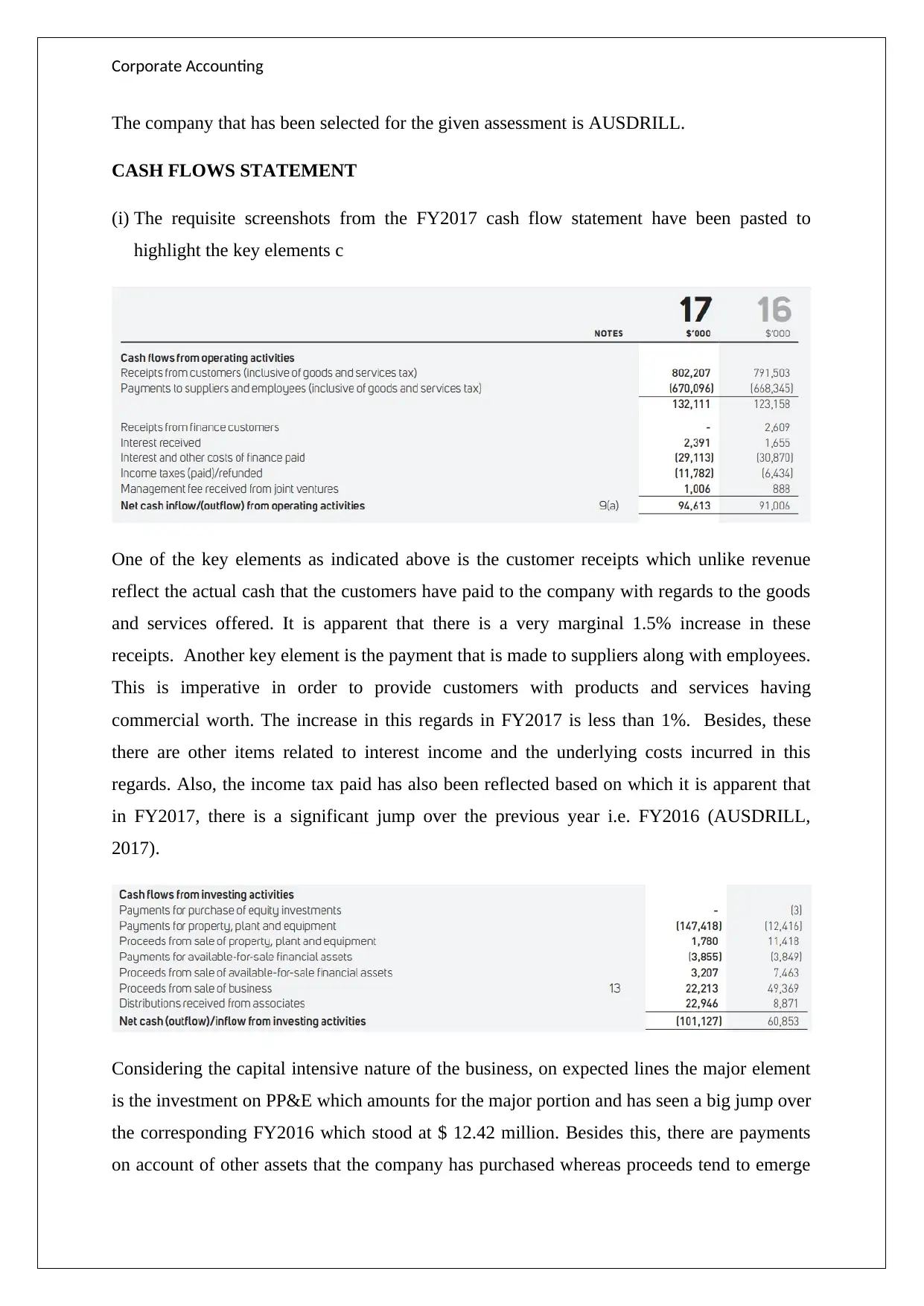
Corporate Accounting
The company that has been selected for the given assessment is AUSDRILL.
CASH FLOWS STATEMENT
(i) The requisite screenshots from the FY2017 cash flow statement have been pasted to
highlight the key elements c
One of the key elements as indicated above is the customer receipts which unlike revenue
reflect the actual cash that the customers have paid to the company with regards to the goods
and services offered. It is apparent that there is a very marginal 1.5% increase in these
receipts. Another key element is the payment that is made to suppliers along with employees.
This is imperative in order to provide customers with products and services having
commercial worth. The increase in this regards in FY2017 is less than 1%. Besides, these
there are other items related to interest income and the underlying costs incurred in this
regards. Also, the income tax paid has also been reflected based on which it is apparent that
in FY2017, there is a significant jump over the previous year i.e. FY2016 (AUSDRILL,
2017).
Considering the capital intensive nature of the business, on expected lines the major element
is the investment on PP&E which amounts for the major portion and has seen a big jump over
the corresponding FY2016 which stood at $ 12.42 million. Besides this, there are payments
on account of other assets that the company has purchased whereas proceeds tend to emerge
The company that has been selected for the given assessment is AUSDRILL.
CASH FLOWS STATEMENT
(i) The requisite screenshots from the FY2017 cash flow statement have been pasted to
highlight the key elements c
One of the key elements as indicated above is the customer receipts which unlike revenue
reflect the actual cash that the customers have paid to the company with regards to the goods
and services offered. It is apparent that there is a very marginal 1.5% increase in these
receipts. Another key element is the payment that is made to suppliers along with employees.
This is imperative in order to provide customers with products and services having
commercial worth. The increase in this regards in FY2017 is less than 1%. Besides, these
there are other items related to interest income and the underlying costs incurred in this
regards. Also, the income tax paid has also been reflected based on which it is apparent that
in FY2017, there is a significant jump over the previous year i.e. FY2016 (AUSDRILL,
2017).
Considering the capital intensive nature of the business, on expected lines the major element
is the investment on PP&E which amounts for the major portion and has seen a big jump over
the corresponding FY2016 which stood at $ 12.42 million. Besides this, there are payments
on account of other assets that the company has purchased whereas proceeds tend to emerge
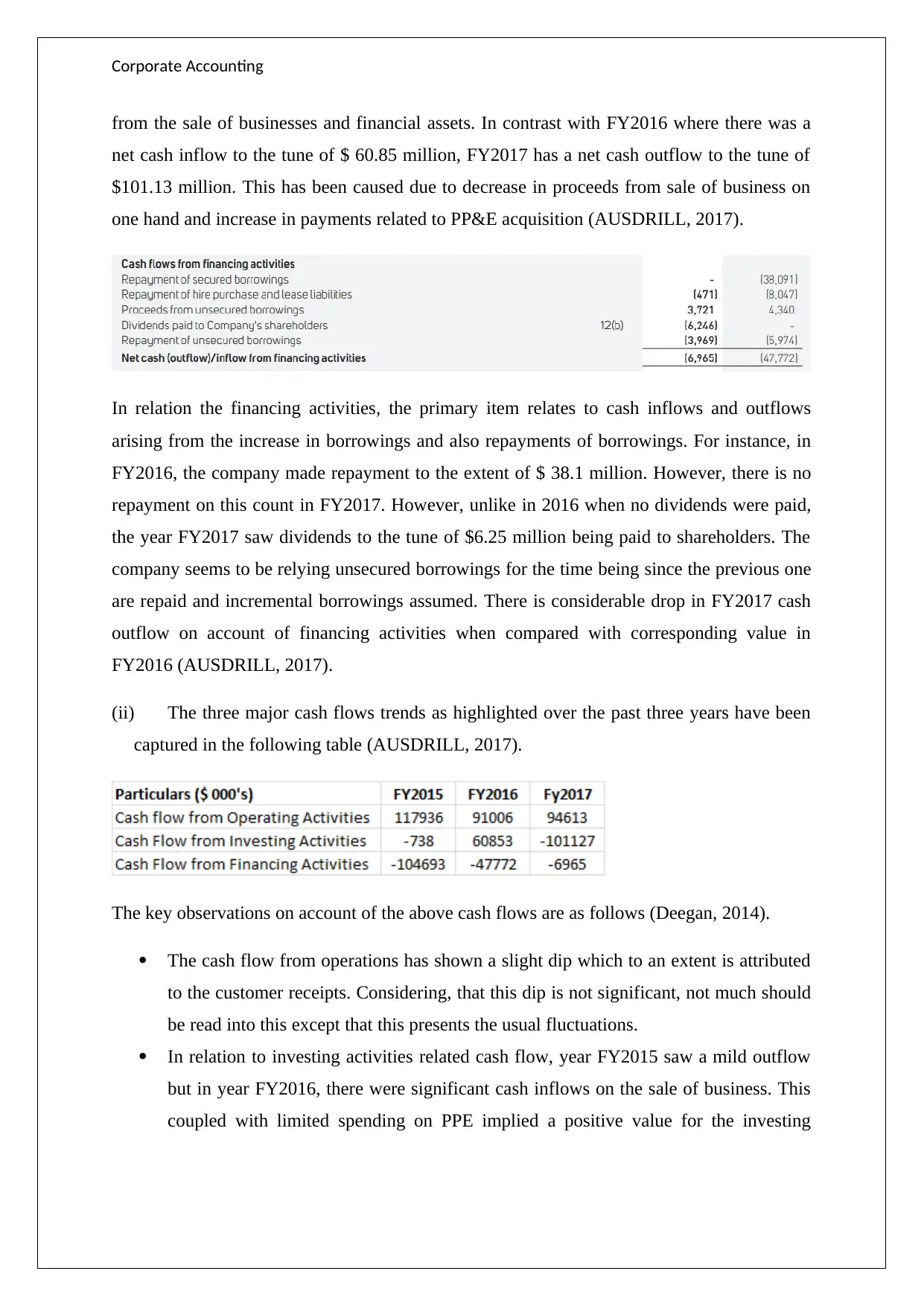
Corporate Accounting
from the sale of businesses and financial assets. In contrast with FY2016 where there was a
net cash inflow to the tune of $ 60.85 million, FY2017 has a net cash outflow to the tune of
$101.13 million. This has been caused due to decrease in proceeds from sale of business on
one hand and increase in payments related to PP&E acquisition (AUSDRILL, 2017).
In relation the financing activities, the primary item relates to cash inflows and outflows
arising from the increase in borrowings and also repayments of borrowings. For instance, in
FY2016, the company made repayment to the extent of $ 38.1 million. However, there is no
repayment on this count in FY2017. However, unlike in 2016 when no dividends were paid,
the year FY2017 saw dividends to the tune of $6.25 million being paid to shareholders. The
company seems to be relying unsecured borrowings for the time being since the previous one
are repaid and incremental borrowings assumed. There is considerable drop in FY2017 cash
outflow on account of financing activities when compared with corresponding value in
FY2016 (AUSDRILL, 2017).
(ii) The three major cash flows trends as highlighted over the past three years have been
captured in the following table (AUSDRILL, 2017).
The key observations on account of the above cash flows are as follows (Deegan, 2014).
The cash flow from operations has shown a slight dip which to an extent is attributed
to the customer receipts. Considering, that this dip is not significant, not much should
be read into this except that this presents the usual fluctuations.
In relation to investing activities related cash flow, year FY2015 saw a mild outflow
but in year FY2016, there were significant cash inflows on the sale of business. This
coupled with limited spending on PPE implied a positive value for the investing
from the sale of businesses and financial assets. In contrast with FY2016 where there was a
net cash inflow to the tune of $ 60.85 million, FY2017 has a net cash outflow to the tune of
$101.13 million. This has been caused due to decrease in proceeds from sale of business on
one hand and increase in payments related to PP&E acquisition (AUSDRILL, 2017).
In relation the financing activities, the primary item relates to cash inflows and outflows
arising from the increase in borrowings and also repayments of borrowings. For instance, in
FY2016, the company made repayment to the extent of $ 38.1 million. However, there is no
repayment on this count in FY2017. However, unlike in 2016 when no dividends were paid,
the year FY2017 saw dividends to the tune of $6.25 million being paid to shareholders. The
company seems to be relying unsecured borrowings for the time being since the previous one
are repaid and incremental borrowings assumed. There is considerable drop in FY2017 cash
outflow on account of financing activities when compared with corresponding value in
FY2016 (AUSDRILL, 2017).
(ii) The three major cash flows trends as highlighted over the past three years have been
captured in the following table (AUSDRILL, 2017).
The key observations on account of the above cash flows are as follows (Deegan, 2014).
The cash flow from operations has shown a slight dip which to an extent is attributed
to the customer receipts. Considering, that this dip is not significant, not much should
be read into this except that this presents the usual fluctuations.
In relation to investing activities related cash flow, year FY2015 saw a mild outflow
but in year FY2016, there were significant cash inflows on the sale of business. This
coupled with limited spending on PPE implied a positive value for the investing
⊘ This is a preview!⊘
Do you want full access?
Subscribe today to unlock all pages.

Trusted by 1+ million students worldwide

Corporate Accounting
activities related cash flow. However, in FY2017, major investments have been done
by the company in PPE which are expected to result in increased future earnings.
In relation to the financing activities related cash flow, the company has ensured that
these have been negative over the last three years which ensures that the company is
taking active measures to minimise the raising of cash from debt so as to strengthen
the balance sheet and to ensure the leveraging remains within limits. Also, a key trend
on the part of the company is to rely more on short term lending through unsecured
borrowing instead of choosing secured borrowing aveneues.
OTHER COMPREHENSIVE INCOME STATEMENT
(iii) The statement highlighting the OCI (Other Comprehensive Income) for the company
is attached as follows (AUSDRILL, 2017).
(iv) The OCI contains various items which are explained below (AUSDRILL, 2017).
“Exchange (losses)/gains on translation of foreign operations”- The financial results of the
company are presented as AUD which acts as the functional currency as well. But,
considering the presence of company abroad especially Africa, the revenue realisation does
not happen in AUD. For the change of currency, there would be some time lag during which
period currency change can happen which would lead to some gains or losses which are
realised here.
The company has enacted joint ventures with different partners and owing to the
comprehensive incomes statement of these joint ventures, the company also needs to
activities related cash flow. However, in FY2017, major investments have been done
by the company in PPE which are expected to result in increased future earnings.
In relation to the financing activities related cash flow, the company has ensured that
these have been negative over the last three years which ensures that the company is
taking active measures to minimise the raising of cash from debt so as to strengthen
the balance sheet and to ensure the leveraging remains within limits. Also, a key trend
on the part of the company is to rely more on short term lending through unsecured
borrowing instead of choosing secured borrowing aveneues.
OTHER COMPREHENSIVE INCOME STATEMENT
(iii) The statement highlighting the OCI (Other Comprehensive Income) for the company
is attached as follows (AUSDRILL, 2017).
(iv) The OCI contains various items which are explained below (AUSDRILL, 2017).
“Exchange (losses)/gains on translation of foreign operations”- The financial results of the
company are presented as AUD which acts as the functional currency as well. But,
considering the presence of company abroad especially Africa, the revenue realisation does
not happen in AUD. For the change of currency, there would be some time lag during which
period currency change can happen which would lead to some gains or losses which are
realised here.
The company has enacted joint ventures with different partners and owing to the
comprehensive incomes statement of these joint ventures, the company also needs to
Paraphrase This Document
Need a fresh take? Get an instant paraphrase of this document with our AI Paraphraser
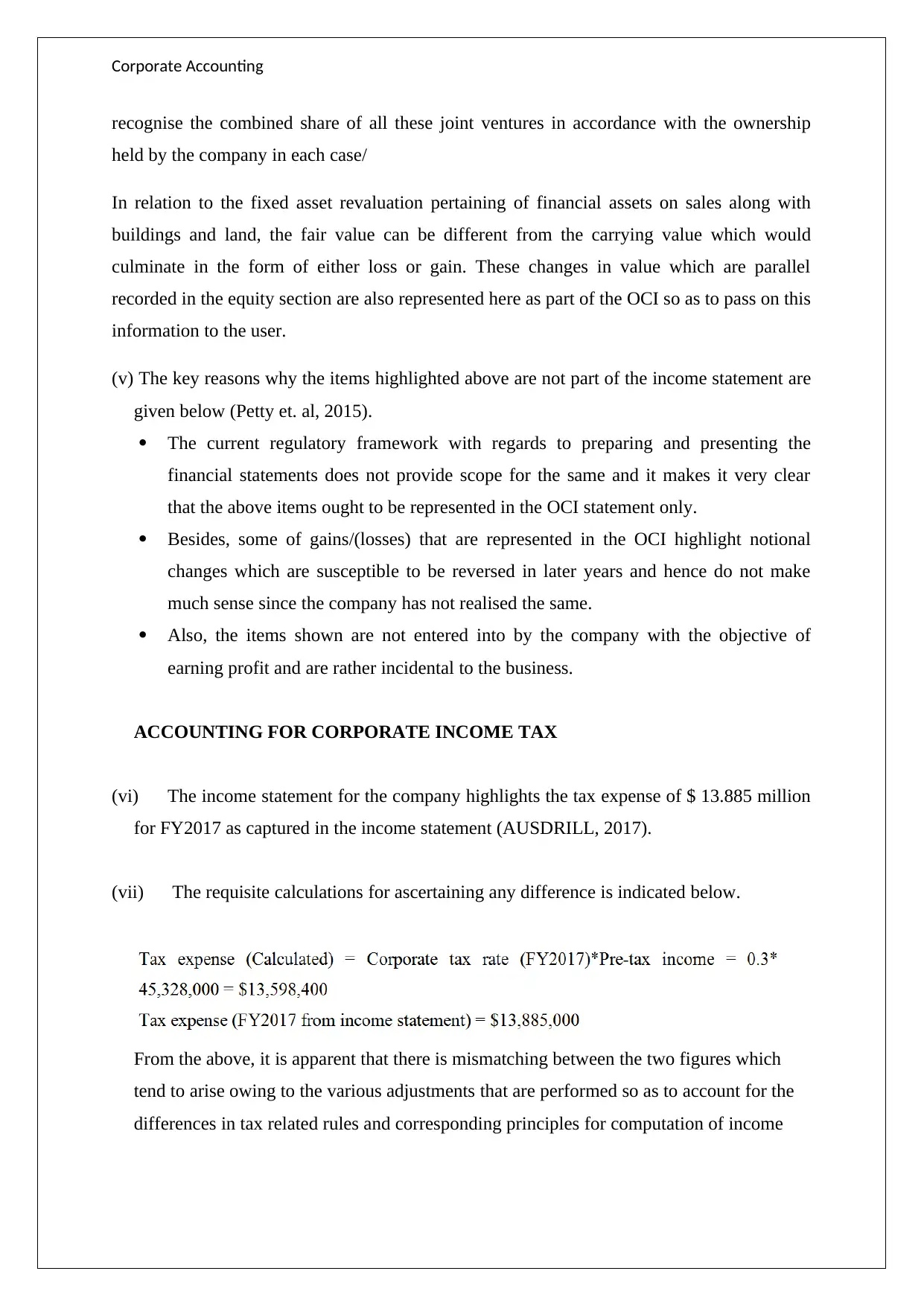
Corporate Accounting
recognise the combined share of all these joint ventures in accordance with the ownership
held by the company in each case/
In relation to the fixed asset revaluation pertaining of financial assets on sales along with
buildings and land, the fair value can be different from the carrying value which would
culminate in the form of either loss or gain. These changes in value which are parallel
recorded in the equity section are also represented here as part of the OCI so as to pass on this
information to the user.
(v) The key reasons why the items highlighted above are not part of the income statement are
given below (Petty et. al, 2015).
The current regulatory framework with regards to preparing and presenting the
financial statements does not provide scope for the same and it makes it very clear
that the above items ought to be represented in the OCI statement only.
Besides, some of gains/(losses) that are represented in the OCI highlight notional
changes which are susceptible to be reversed in later years and hence do not make
much sense since the company has not realised the same.
Also, the items shown are not entered into by the company with the objective of
earning profit and are rather incidental to the business.
ACCOUNTING FOR CORPORATE INCOME TAX
(vi) The income statement for the company highlights the tax expense of $ 13.885 million
for FY2017 as captured in the income statement (AUSDRILL, 2017).
(vii) The requisite calculations for ascertaining any difference is indicated below.
From the above, it is apparent that there is mismatching between the two figures which
tend to arise owing to the various adjustments that are performed so as to account for the
differences in tax related rules and corresponding principles for computation of income
recognise the combined share of all these joint ventures in accordance with the ownership
held by the company in each case/
In relation to the fixed asset revaluation pertaining of financial assets on sales along with
buildings and land, the fair value can be different from the carrying value which would
culminate in the form of either loss or gain. These changes in value which are parallel
recorded in the equity section are also represented here as part of the OCI so as to pass on this
information to the user.
(v) The key reasons why the items highlighted above are not part of the income statement are
given below (Petty et. al, 2015).
The current regulatory framework with regards to preparing and presenting the
financial statements does not provide scope for the same and it makes it very clear
that the above items ought to be represented in the OCI statement only.
Besides, some of gains/(losses) that are represented in the OCI highlight notional
changes which are susceptible to be reversed in later years and hence do not make
much sense since the company has not realised the same.
Also, the items shown are not entered into by the company with the objective of
earning profit and are rather incidental to the business.
ACCOUNTING FOR CORPORATE INCOME TAX
(vi) The income statement for the company highlights the tax expense of $ 13.885 million
for FY2017 as captured in the income statement (AUSDRILL, 2017).
(vii) The requisite calculations for ascertaining any difference is indicated below.
From the above, it is apparent that there is mismatching between the two figures which
tend to arise owing to the various adjustments that are performed so as to account for the
differences in tax related rules and corresponding principles for computation of income
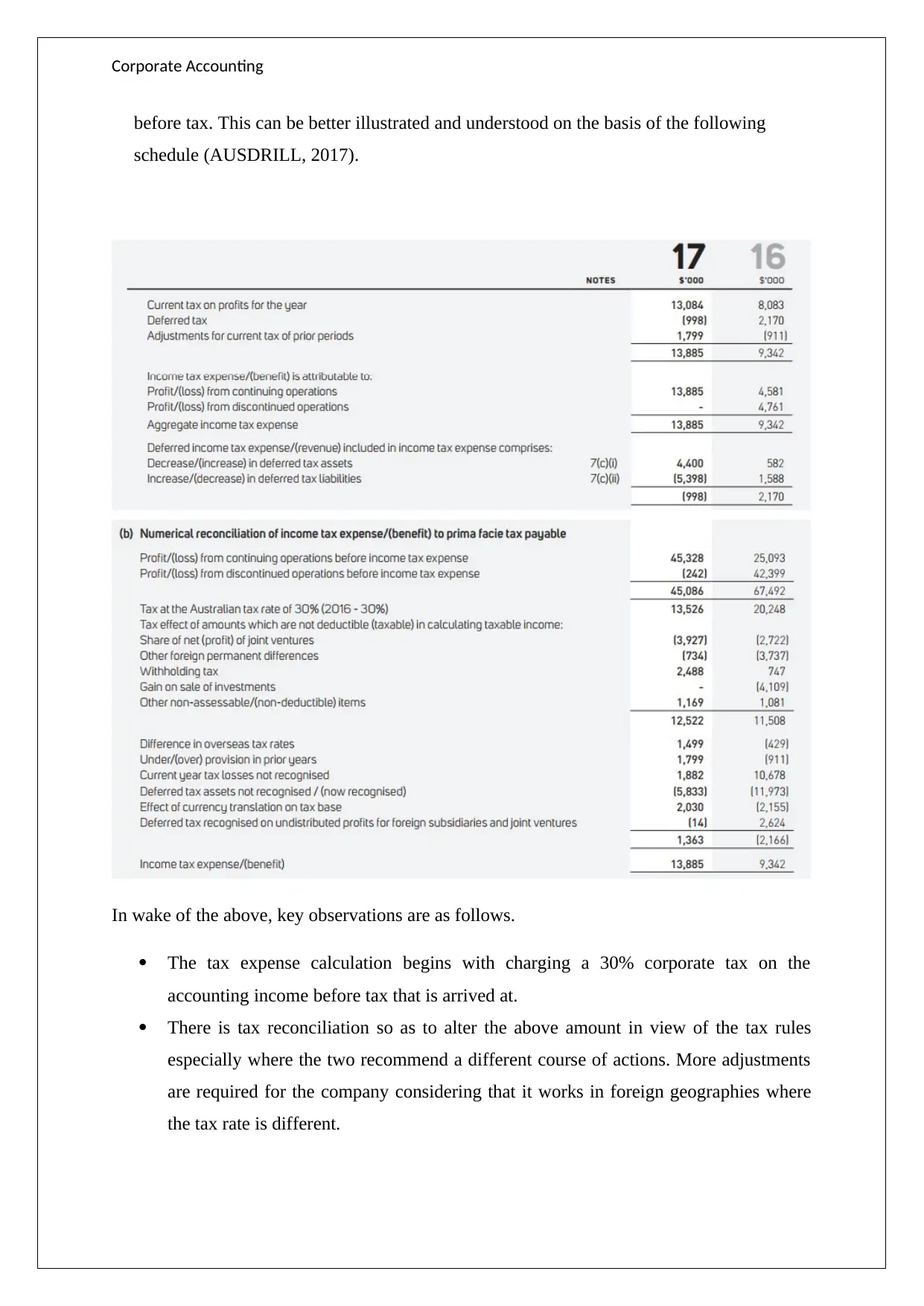
Corporate Accounting
before tax. This can be better illustrated and understood on the basis of the following
schedule (AUSDRILL, 2017).
In wake of the above, key observations are as follows.
The tax expense calculation begins with charging a 30% corporate tax on the
accounting income before tax that is arrived at.
There is tax reconciliation so as to alter the above amount in view of the tax rules
especially where the two recommend a different course of actions. More adjustments
are required for the company considering that it works in foreign geographies where
the tax rate is different.
before tax. This can be better illustrated and understood on the basis of the following
schedule (AUSDRILL, 2017).
In wake of the above, key observations are as follows.
The tax expense calculation begins with charging a 30% corporate tax on the
accounting income before tax that is arrived at.
There is tax reconciliation so as to alter the above amount in view of the tax rules
especially where the two recommend a different course of actions. More adjustments
are required for the company considering that it works in foreign geographies where
the tax rate is different.
⊘ This is a preview!⊘
Do you want full access?
Subscribe today to unlock all pages.

Trusted by 1+ million students worldwide
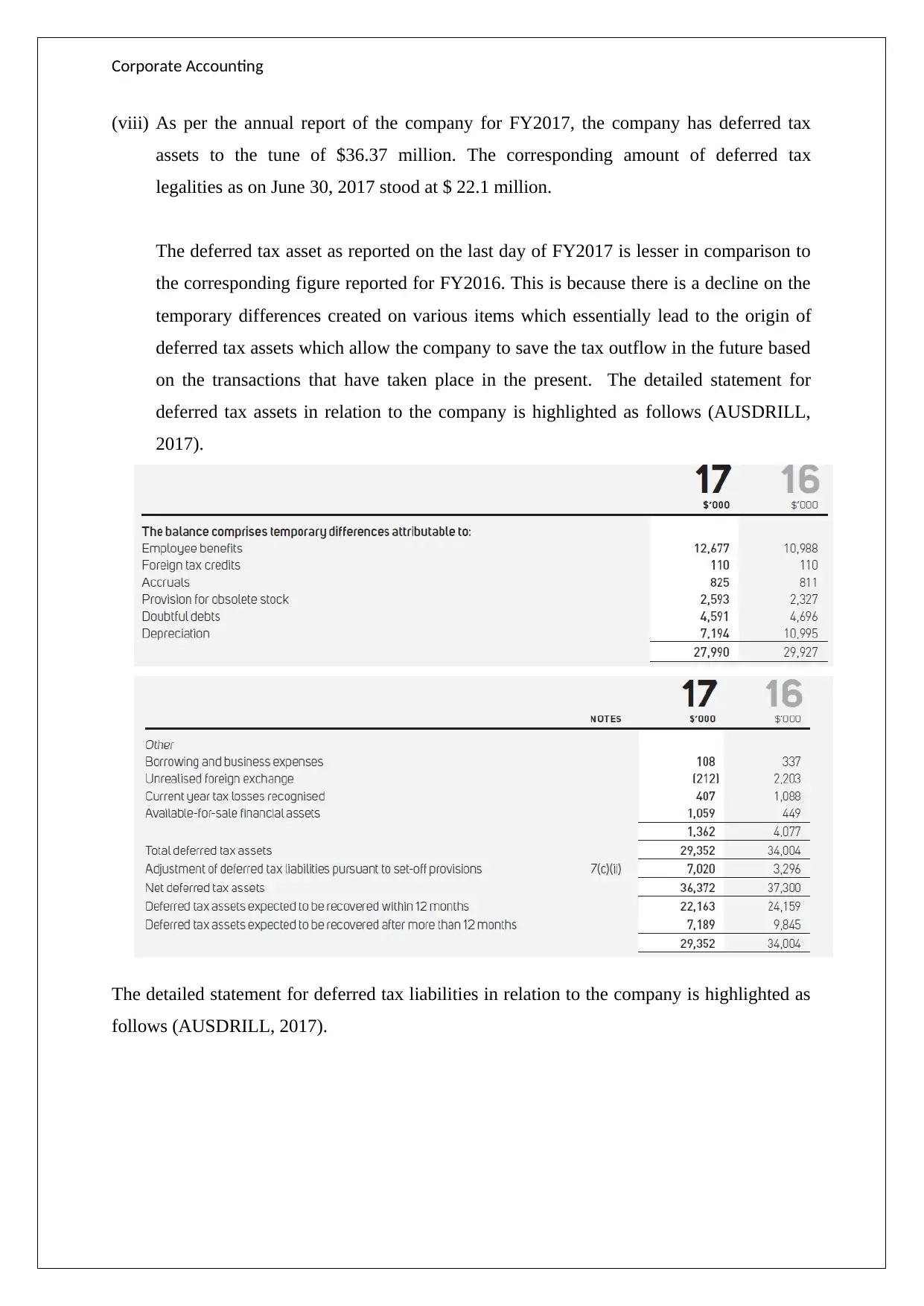
Corporate Accounting
(viii) As per the annual report of the company for FY2017, the company has deferred tax
assets to the tune of $36.37 million. The corresponding amount of deferred tax
legalities as on June 30, 2017 stood at $ 22.1 million.
The deferred tax asset as reported on the last day of FY2017 is lesser in comparison to
the corresponding figure reported for FY2016. This is because there is a decline on the
temporary differences created on various items which essentially lead to the origin of
deferred tax assets which allow the company to save the tax outflow in the future based
on the transactions that have taken place in the present. The detailed statement for
deferred tax assets in relation to the company is highlighted as follows (AUSDRILL,
2017).
The detailed statement for deferred tax liabilities in relation to the company is highlighted as
follows (AUSDRILL, 2017).
(viii) As per the annual report of the company for FY2017, the company has deferred tax
assets to the tune of $36.37 million. The corresponding amount of deferred tax
legalities as on June 30, 2017 stood at $ 22.1 million.
The deferred tax asset as reported on the last day of FY2017 is lesser in comparison to
the corresponding figure reported for FY2016. This is because there is a decline on the
temporary differences created on various items which essentially lead to the origin of
deferred tax assets which allow the company to save the tax outflow in the future based
on the transactions that have taken place in the present. The detailed statement for
deferred tax assets in relation to the company is highlighted as follows (AUSDRILL,
2017).
The detailed statement for deferred tax liabilities in relation to the company is highlighted as
follows (AUSDRILL, 2017).
Paraphrase This Document
Need a fresh take? Get an instant paraphrase of this document with our AI Paraphraser

Corporate Accounting
The deferred tax liabilities as reported on the last day of FY2017 are lesser in comparison to
the corresponding figure reported for FY2016. This is because there is a decline on the
temporary differences created on various items which essentially lead to the origin of
deferred tax liabilities which oblige the company with increasing the tax outflow in the future
based on the transactions that have taken place in the present
(ix) The current tax assets on the balance sheet of the company as on June 30, 2017 stood
at $3.03 million. The corresponding amount at the closing of the previous financial year
was at $4.80 million (AUSDRILL, 2017). These current tax assets would enable the
company to reduce their tax outflow or increase tax refunds in the next financial year and
the amount highlights the extent of benefits (Petty et. al., 2012).
The income tax expense and income tax payable are not the same. The main reason for the
same is that tax expense highlights the total amount of tax that the company must pay to
the tax department for a given year. However, during the year based on the likely
estimates of sales and profits, the company usually tend to pay taxes for the current year
on an ongoing basis. As a result, the tax payable at the end would be computed by the
difference of income tax expense and income tax paid (Deegan, 2014).
Hence, income tax payable = Income tax expense – Income tax actually paid for the
given assessment year
The deferred tax liabilities as reported on the last day of FY2017 are lesser in comparison to
the corresponding figure reported for FY2016. This is because there is a decline on the
temporary differences created on various items which essentially lead to the origin of
deferred tax liabilities which oblige the company with increasing the tax outflow in the future
based on the transactions that have taken place in the present
(ix) The current tax assets on the balance sheet of the company as on June 30, 2017 stood
at $3.03 million. The corresponding amount at the closing of the previous financial year
was at $4.80 million (AUSDRILL, 2017). These current tax assets would enable the
company to reduce their tax outflow or increase tax refunds in the next financial year and
the amount highlights the extent of benefits (Petty et. al., 2012).
The income tax expense and income tax payable are not the same. The main reason for the
same is that tax expense highlights the total amount of tax that the company must pay to
the tax department for a given year. However, during the year based on the likely
estimates of sales and profits, the company usually tend to pay taxes for the current year
on an ongoing basis. As a result, the tax payable at the end would be computed by the
difference of income tax expense and income tax paid (Deegan, 2014).
Hence, income tax payable = Income tax expense – Income tax actually paid for the
given assessment year
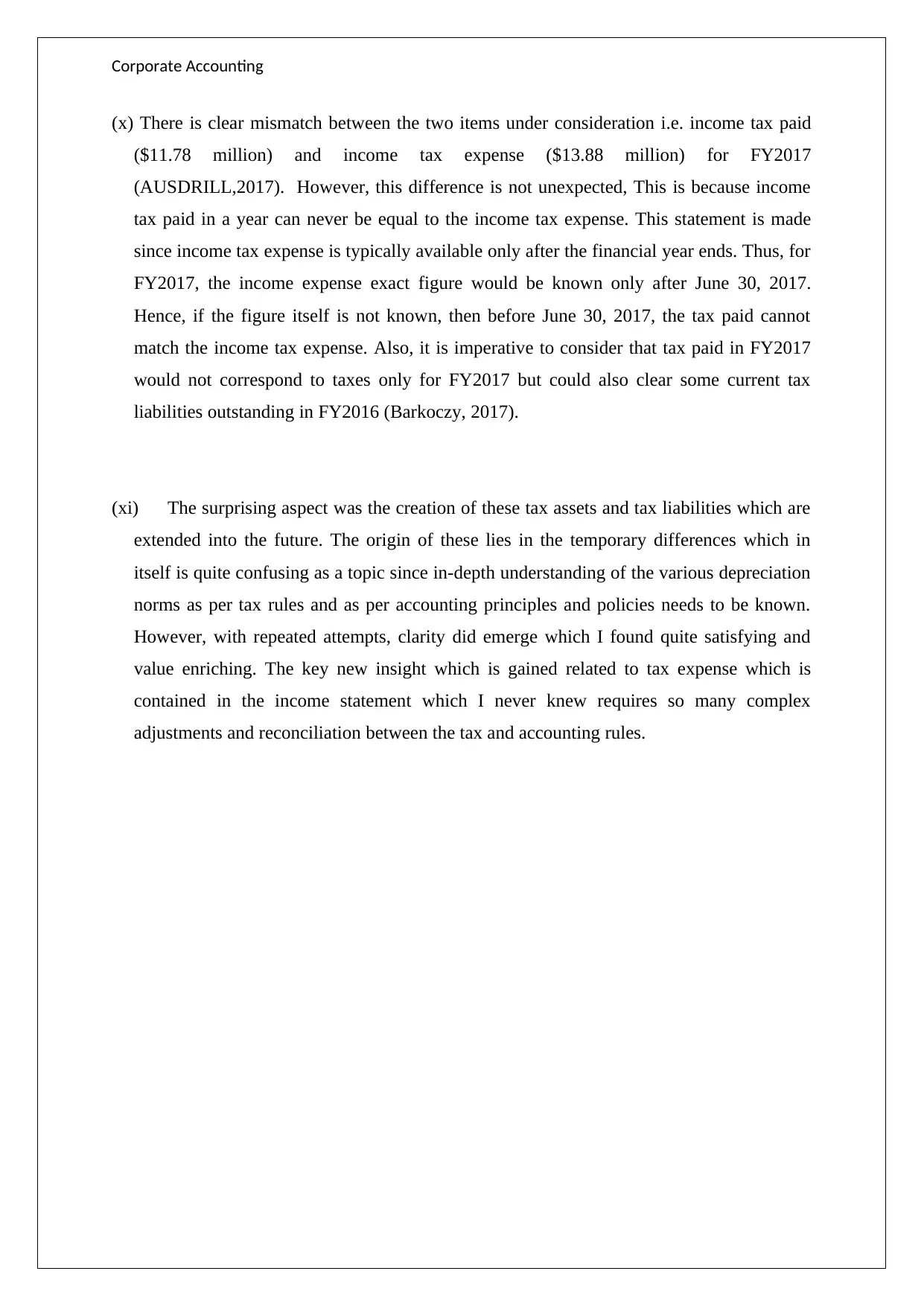
Corporate Accounting
(x) There is clear mismatch between the two items under consideration i.e. income tax paid
($11.78 million) and income tax expense ($13.88 million) for FY2017
(AUSDRILL,2017). However, this difference is not unexpected, This is because income
tax paid in a year can never be equal to the income tax expense. This statement is made
since income tax expense is typically available only after the financial year ends. Thus, for
FY2017, the income expense exact figure would be known only after June 30, 2017.
Hence, if the figure itself is not known, then before June 30, 2017, the tax paid cannot
match the income tax expense. Also, it is imperative to consider that tax paid in FY2017
would not correspond to taxes only for FY2017 but could also clear some current tax
liabilities outstanding in FY2016 (Barkoczy, 2017).
(xi) The surprising aspect was the creation of these tax assets and tax liabilities which are
extended into the future. The origin of these lies in the temporary differences which in
itself is quite confusing as a topic since in-depth understanding of the various depreciation
norms as per tax rules and as per accounting principles and policies needs to be known.
However, with repeated attempts, clarity did emerge which I found quite satisfying and
value enriching. The key new insight which is gained related to tax expense which is
contained in the income statement which I never knew requires so many complex
adjustments and reconciliation between the tax and accounting rules.
(x) There is clear mismatch between the two items under consideration i.e. income tax paid
($11.78 million) and income tax expense ($13.88 million) for FY2017
(AUSDRILL,2017). However, this difference is not unexpected, This is because income
tax paid in a year can never be equal to the income tax expense. This statement is made
since income tax expense is typically available only after the financial year ends. Thus, for
FY2017, the income expense exact figure would be known only after June 30, 2017.
Hence, if the figure itself is not known, then before June 30, 2017, the tax paid cannot
match the income tax expense. Also, it is imperative to consider that tax paid in FY2017
would not correspond to taxes only for FY2017 but could also clear some current tax
liabilities outstanding in FY2016 (Barkoczy, 2017).
(xi) The surprising aspect was the creation of these tax assets and tax liabilities which are
extended into the future. The origin of these lies in the temporary differences which in
itself is quite confusing as a topic since in-depth understanding of the various depreciation
norms as per tax rules and as per accounting principles and policies needs to be known.
However, with repeated attempts, clarity did emerge which I found quite satisfying and
value enriching. The key new insight which is gained related to tax expense which is
contained in the income statement which I never knew requires so many complex
adjustments and reconciliation between the tax and accounting rules.
⊘ This is a preview!⊘
Do you want full access?
Subscribe today to unlock all pages.

Trusted by 1+ million students worldwide
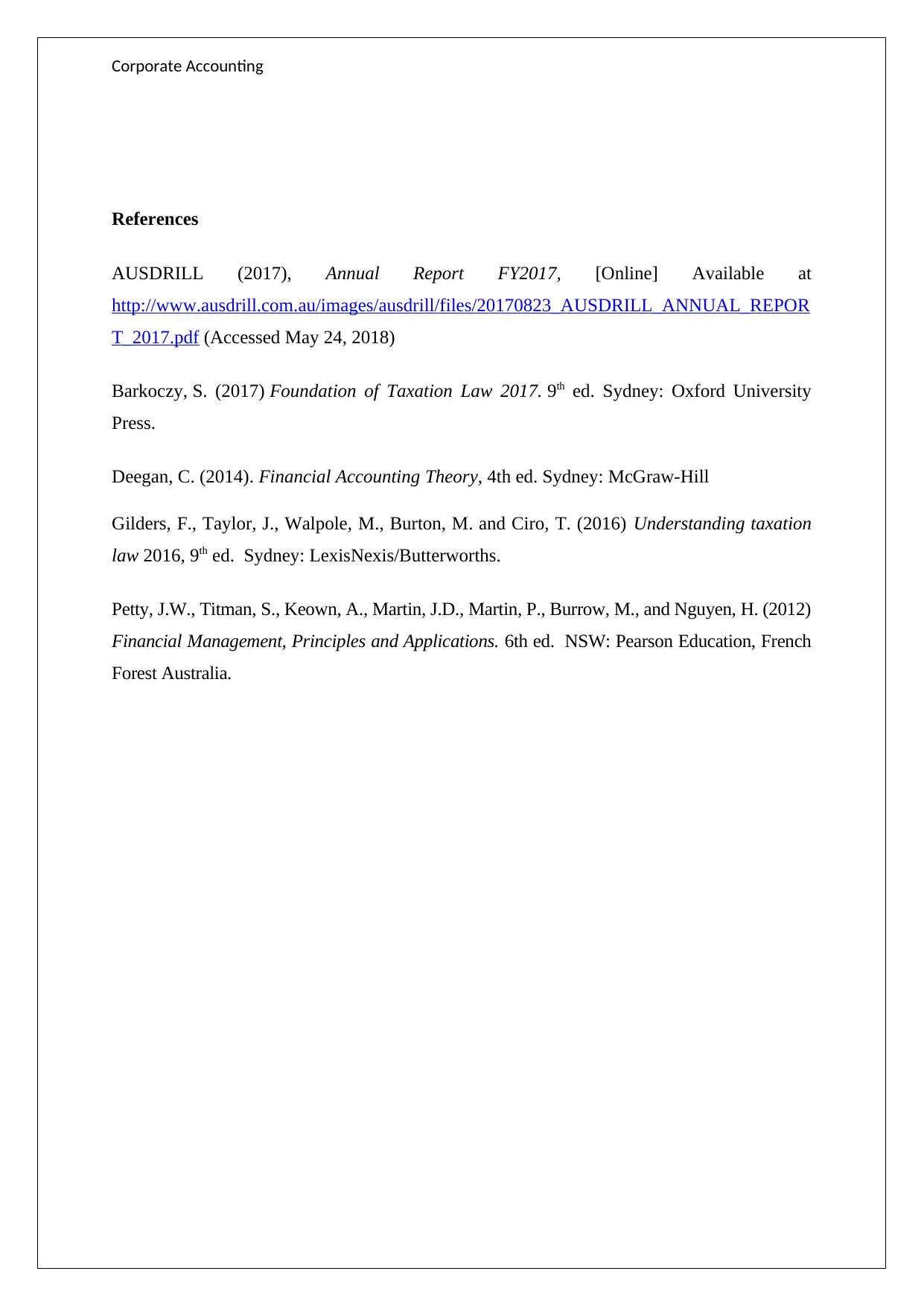
Corporate Accounting
References
AUSDRILL (2017), Annual Report FY2017, [Online] Available at
http://www.ausdrill.com.au/images/ausdrill/files/20170823_AUSDRILL_ANNUAL_REPOR
T_2017.pdf (Accessed May 24, 2018)
Barkoczy, S. (2017) Foundation of Taxation Law 2017. 9th ed. Sydney: Oxford University
Press.
Deegan, C. (2014). Financial Accounting Theory, 4th ed. Sydney: McGraw-Hill
Gilders, F., Taylor, J., Walpole, M., Burton, M. and Ciro, T. (2016) Understanding taxation
law 2016, 9th ed. Sydney: LexisNexis/Butterworths.
Petty, J.W., Titman, S., Keown, A., Martin, J.D., Martin, P., Burrow, M., and Nguyen, H. (2012)
Financial Management, Principles and Applications. 6th ed. NSW: Pearson Education, French
Forest Australia.
References
AUSDRILL (2017), Annual Report FY2017, [Online] Available at
http://www.ausdrill.com.au/images/ausdrill/files/20170823_AUSDRILL_ANNUAL_REPOR
T_2017.pdf (Accessed May 24, 2018)
Barkoczy, S. (2017) Foundation of Taxation Law 2017. 9th ed. Sydney: Oxford University
Press.
Deegan, C. (2014). Financial Accounting Theory, 4th ed. Sydney: McGraw-Hill
Gilders, F., Taylor, J., Walpole, M., Burton, M. and Ciro, T. (2016) Understanding taxation
law 2016, 9th ed. Sydney: LexisNexis/Butterworths.
Petty, J.W., Titman, S., Keown, A., Martin, J.D., Martin, P., Burrow, M., and Nguyen, H. (2012)
Financial Management, Principles and Applications. 6th ed. NSW: Pearson Education, French
Forest Australia.
1 out of 10
Related Documents
Your All-in-One AI-Powered Toolkit for Academic Success.
+13062052269
info@desklib.com
Available 24*7 on WhatsApp / Email
![[object Object]](/_next/static/media/star-bottom.7253800d.svg)
Unlock your academic potential
Copyright © 2020–2026 A2Z Services. All Rights Reserved. Developed and managed by ZUCOL.





